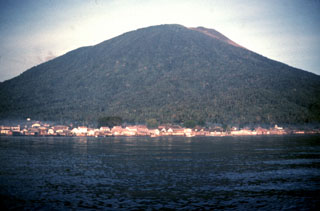Report on Gamalama (Indonesia) — September 2003
Bulletin of the Global Volcanism Network, vol. 28, no. 9 (September 2003)
Managing Editor: Edward Venzke.
Gamalama (Indonesia) Several small ash explosions and gas emission through late September
Please cite this report as:
Global Volcanism Program, 2003. Report on Gamalama (Indonesia) (Venzke, E., ed.). Bulletin of the Global Volcanism Network, 28:9. Smithsonian Institution. https://doi.org/10.5479/si.GVP.BGVN200309-268060
Gamalama
Indonesia
0.81°N, 127.3322°E; summit elev. 1714 m
All times are local (unless otherwise noted)
An eruptive event on 31 July 2003 at Gamalama produced ashfall and pyroclastic flows (BGVN 28:07). The Volcanological Survey of Indonesia (VSI) report for the week of 28 July-3 August noted that the hazard status was downgraded to Alert Level 3 on 2 August. A white gas plume was reported as rising 10-50 m above the summit and the seismograph record was dominated by emission events.
Volcanic activity was low during 18-31 August, with white gas emissions and several small ash explosions. White-gray ash plumes emitted from the crater reached 100 m high. Night glow was seen just above the crater rim. Recorded emission and tectonic earthquakes averaged four events per day. Reduced activity continued during 1-28 September 2003, again with white gas emission and small ash explosions that occurred several times. Seismicity was dominated by tectonic and emission events (table 1). The hazard status since 18 August has been at Alert Level 2 (on a scale of 1-4).
Table 1. Seismicity at Gamalama during 1-28 September 2003. Courtesy of VSI.
| Dates | Deep Volcanic | Shallow Volcanic | Emission | Tectonic |
| 01-07 Sep 2003 | 1 | 7 | 35 | 64 |
| 08-14 Sep 2003 | 3 | 1 | 16 | 59 |
| 15-21 Sep 2003 | 0 | 1 | 12 | 57 |
| 22-28 Sep 2003 | 0 | 3 | 21 | 49 |
Geological Summary. Gamalama is a near-conical stratovolcano that comprises the entire island of Ternate off the western coast of Halmahera, and is one of Indonesia's most active volcanoes. The island was a major regional center in the Portuguese and Dutch spice trade for several centuries, which contributed to the extensive documentation of activity. Three cones, progressively younger to the north, form the summit. Several maars and vents define a rift zone, parallel to the Halmahera island arc, that cuts the volcano; the S-flank Ngade maar formed after about 14,500–13,000 cal. BP (Faral et al., 2022). Eruptions, recorded frequently since the 16th century, typically originated from the summit craters, although flank eruptions have occurred in 1763, 1770, 1775, and 1962-63.
Information Contacts: Dali Ahmad, Volcanological Survey of Indonesia (VSI), Jalan Diponegoro No. 57, Bandung 40122, Indonesia (URL: http://www.vsi.esdm.go.id/).

